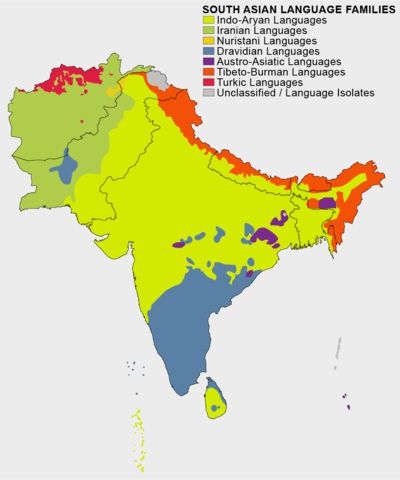Languages of South Asia

The languages of South Asia include a few major language families:
- Indo-Iranian languages, a branch of the Indo-European language family, which can be further divided into three groups:
- Indo-Aryan languages, the most widespread.[1][2]
- Iranic languages, in Pakistan and Afghanistan.[1][2]
- Nuristani languages, in a small area of Afghanistan and Pakistan.[2]
- Dravidian languages, in South India and Sri Lanka.[1][2]
- Tibeto-Burman languages, a branch of the Sino-Tibetan language family, along the northern and eastern edges.[1][2]
- Austroasiatic languages, in small areas of India.[1][2]
- There are also some people who speak Kra-Dai languages, and some language isolates such as Burushaski, which are not known to be related to any other languages.[2]
South Asia includes India, Pakistan, Bangladesh, Sri Lanka, Nepal, Bhutan, the Maldives, and sometimes Afghanistan.
Indo-Aryan languages[change | change source]
Most Indo-Aryan languages grew from Sanskrit, an ancient language. It is hard to decide to define what is a language, and what is just a dialect (language variant). For example, Hindi and Urdu are similar when spoken, but Hindi is written in the Devanagari script and Urdu is written in the Persian-Arabic script. Hindi uses more words from Sanskrit, while Urdu uses more words from Persian and Arabic.[2]
| Language | Number of people who speak this language[3] | Places where people speak this language |
|---|---|---|
| Hindi | 515,500,000 | North India (Bihar, Chhattisgarh, Delhi, Haryana, Jharkhand, Madhya Pradesh, Rajasthan, Uttar Pradesh, Uttarakhand) |
| Bengali | 265,000,000 | Bangladesh, West Bengal, Tripura |
| Urdu | 17,200,000 | Pakistan, parts of India (Uttar Pradesh, Delhi, Kashmir, Madhya Pradesh) |
| Marathi | 95,300,000 | Maharashtra |
| Panjabi | 154,500,000 | United Panjab (Pak Panjab,Ind Panjab, Haryana, Himachal,Chandigarh, Delhi and Hazara divison of present day Kyber Paktunistan |
| Gujarati | 60,600,000 | Gujarat |
| Bhojpuri | 52,400,000 | western Bihar, eastern Uttar Pradesh, Nepal |
| Odia | 38,000,000 | Odisha |
| Maithili | 34,000,000 | eastern Bihar, eastern Jharkhand, Nepal |
| Sindhi | 32,600,000 | Sindh, Balochistan, northern Gujarat |
| Nepali | 24,500,000 | Nepal, Sikkim, Bhutan |
| Magahi | 20,700,000 | southern Bihar, eastern Jharkhand, northern West Bengal |
| Sinhala | 17,300,000 | Sri Lanka |
| Chhattisgarhi | 16,300,000 | Chhattisgarh |
| Assamese | 15,300,000 | Assam |
| Chittagonian | 13,000,000 | eastern Bangladesh |
| Deccan | 12,800,000 | northern Karnataka |
| Sadri | 12,100,000 | Jharkhand, eastern Chhattisgarh, northern Odisha, southern Bihar |
| Sylheti | 11,800,000 | eastern Bangladesh, southern Assam |
Iranic languages[change | change source]
Only some of the Iranic languages are from South Asia. Others are from West Asia or Central Asia.[1][4] This table shows the total number of people who speak each language.
| Language | Number of people who speak this language | Places where people speak this language |
|---|---|---|
| Pashto | 40,000,000 | Afghanistan, Khyber Pakhtunkhwa |
| Dari Persian | 20,500,000[5] | Afghanistan |
| Balochi | 10,000,000[6] | Balochistan |
Nuristani languages[change | change source]
About 130,000 people speak the five Nuristani languages.[2]
Dravidian languages[change | change source]
| Language | Number of people who speak this language[3] | Places where people speak this language |
|---|---|---|
| Telugu | 93,000,000 | Andhra Pradesh, Telangana |
| Tamil | 81,000,000 | Tamil Nadu, Sri Lanka |
| Kannada | 56,400,000 | Karnataka |
| Malayalam | 37,800,000 | Kerala |
| Brahui | 3,300,000[7] | central Balochistan |
| Gondi | 3,000,000[8] | Madhya Pradesh, Odisha, Andhra Pradesh, Maharashtra[9] |
| Kurukh | 2,300,000[10] | Jharkhand, Madhya Pradesh, Chhattisgarh, Odisha, West Bengal, northern Bangladesh |
| Tulu | 1,900,000[8] | western Karnataka, northern Kerala |
| Beary | 1,700,000[8] | western Karnataka, northern Kerala |
Tibeto-Burman languages[change | change source]
A number of Tibeto-Burman languages are spoken in Nepal, Bhutan, Northeast India, Bangladesh, North India, and North Pakistan.
Austroasiatic languages[change | change source]
Most Austroasiatic languages are spoken in Southeast Asia, rather than South Asia. The Austronesian languages spoken in South Asia are part of the Munda and Khasic branches.[2]
Kra-Dai languages[change | change source]
Most Kra-Dai languages are spoken in East Asia and Southeast Asia. About 10,000 people speak these languages in South Asia, in Assam and the surrounding area.[2]
Language isolates[change | change source]
A language isolate is a language that is not known to be related to any other languages.
There are several native languages to the Andaman Islands. Originally they were grouped into Great Andamanese, Ongan, Jangil, and Sentinelese. Today, people have stopped speaking some of these languages, making them extinct.
The Burushaski language is spoken by about 100,000 people in North Pakistan. The Kusunda language is spoken by less than 100 people in Nepal. The Nihali language is spoken by 2,000 or so people in Madhya Pradesh and Maharashtra. All of these are considered language isolates.[2]
References[change | change source]
- ↑ 1.0 1.1 1.2 1.3 1.4 1.5 "Linguistic landscaping of South Asia using digital language resources: Genetic vs. areal linguistics" (PDF). 2014.
{{cite journal}}: Cite journal requires|journal=(help) - ↑ 2.00 2.01 2.02 2.03 2.04 2.05 2.06 2.07 2.08 2.09 2.10 2.11 The languages and linguistics of South Asia : a comprehensive guide. Berlin. 2016. ISBN 978-3-11-042330-3. OCLC 951075713.
{{cite book}}: CS1 maint: location missing publisher (link) - ↑ 3.0 3.1 Ghosh, Iman (2020-02-15). "Ranked: The 100 Most Spoken Languages Around the World". Visual Capitalist. Retrieved 2020-09-11.
- ↑ "Home Page | Iranian Languages". iranian-languages.arizona.edu. Retrieved 2020-09-11.
- ↑ "Dari". Ethnologue. Retrieved 2020-09-11.
- ↑ Jahani, Carina. "The Balochi Language Project - Institutionen för lingvistik och filologi - Uppsala universitet". www.lingfil.uu.se (in Swedish). Retrieved 2020-09-11.
- ↑ "Brahui". Ethnologue. Retrieved 2020-09-11.
- ↑ 8.0 8.1 8.2 "Data on Language and Mother Tongue". Census of India. 2011. Retrieved 2020-09-11.
- ↑ Beine, David Karl (2013). A Sociolinguistic Survey of the Gondi-speaking Communities of Central India (PDF). SIL International.
- ↑ "Kurux". Ethnologue. Retrieved 2020-09-11.
